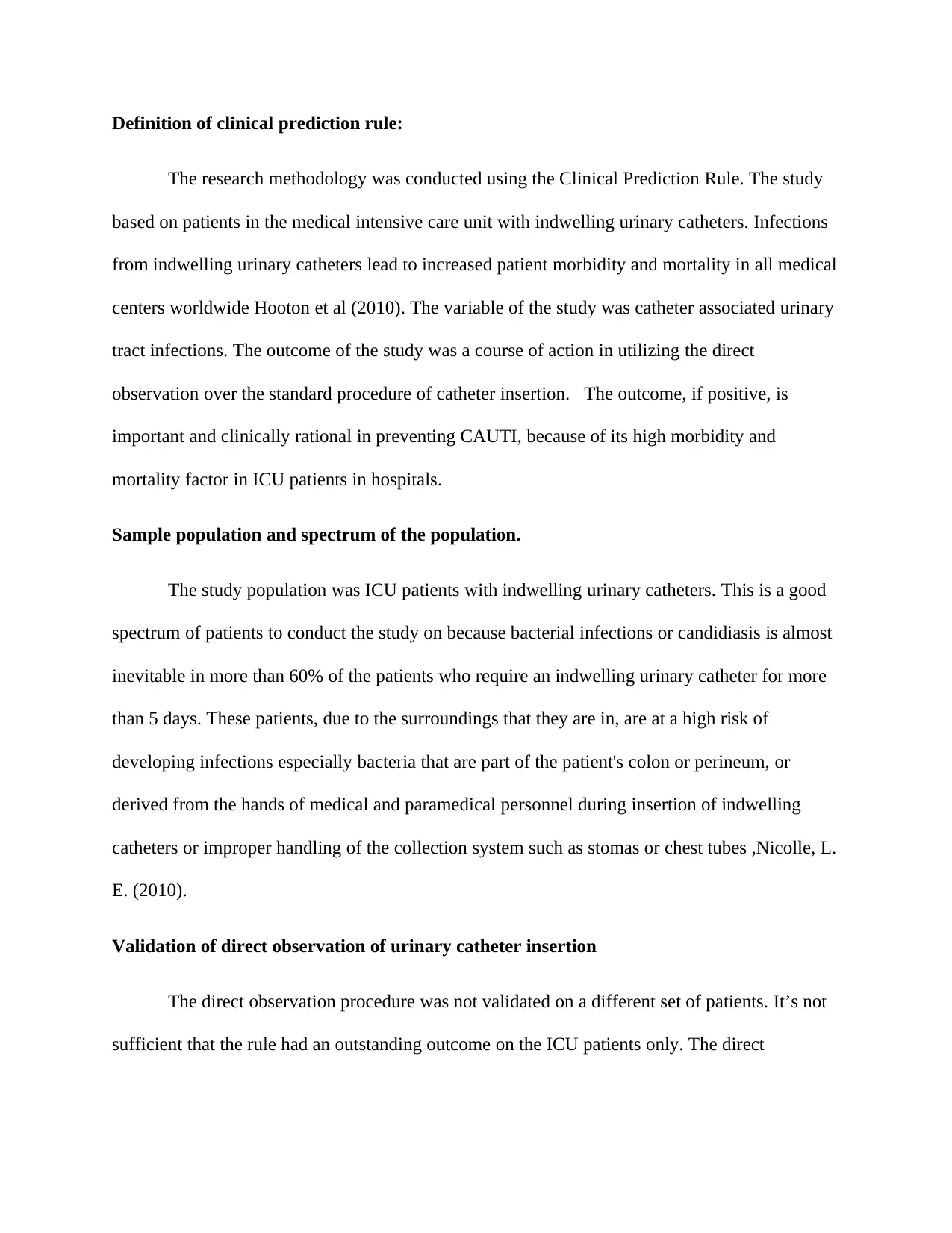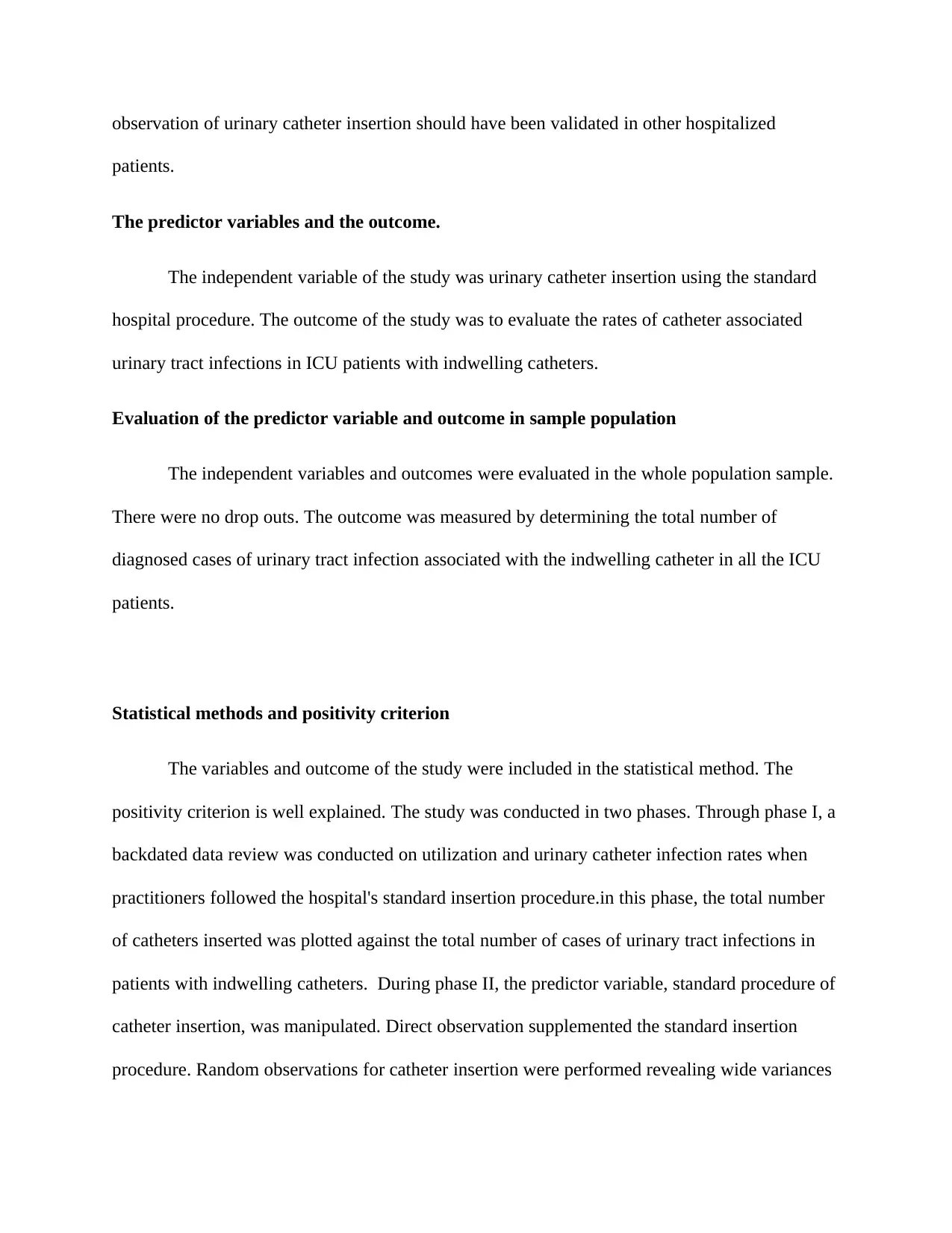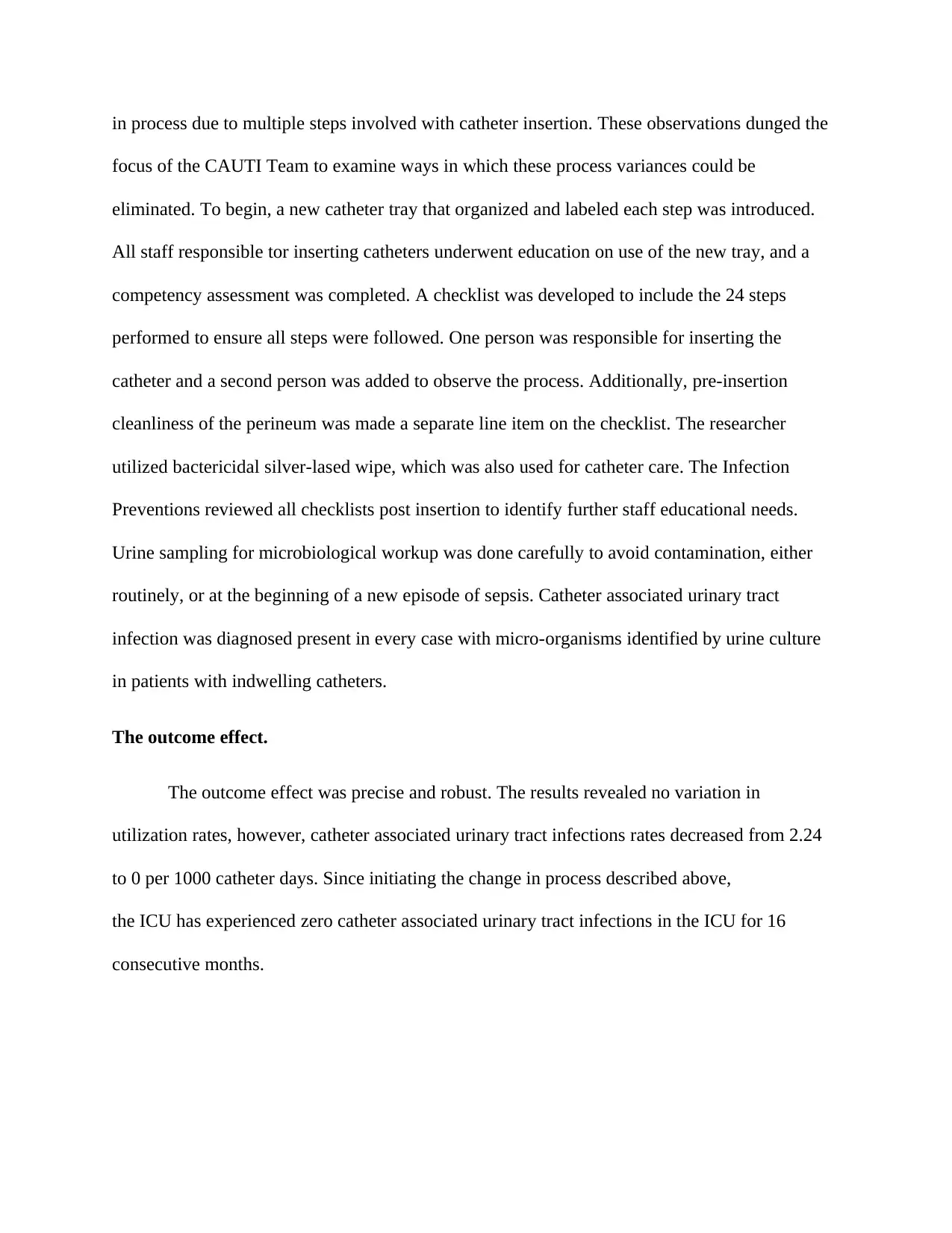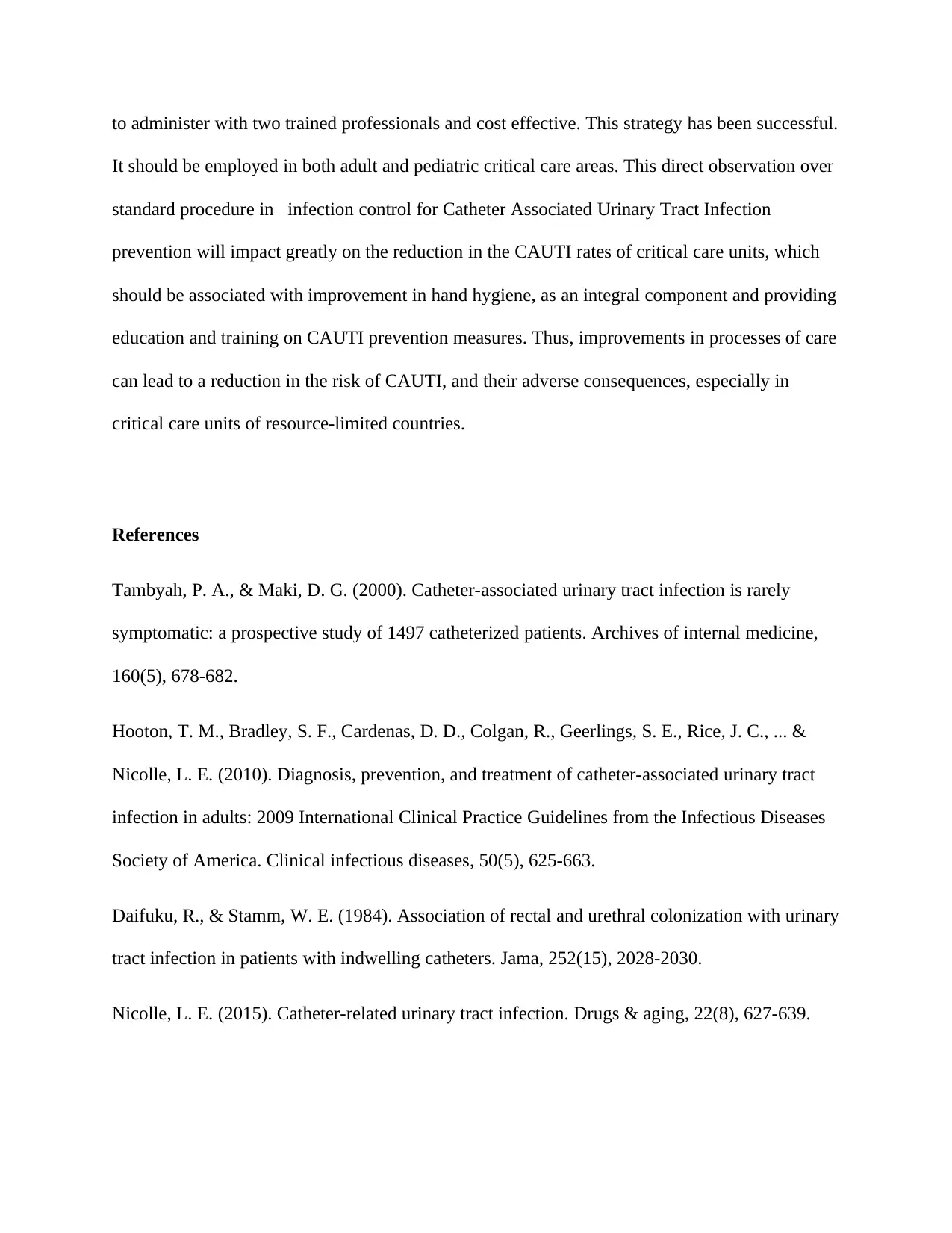Evidence-Based Nursing Research: CAUTI Intervention Appraisal
VerifiedAdded on 2023/06/12
|6
|1402
|156
Report
AI Summary
This report presents a critical appraisal of a research article focusing on an intervention to improve catheter-associated urinary tract infection (CAUTI) rates in a medical intensive care unit (ICU) through direct observation of catheter insertion procedures. The appraisal evaluates the study's methodology, sample population, validation of direct observation, predictor variables, statistical methods, and outcome effects. It highlights the study's findings, which demonstrate a significant reduction in CAUTI rates following the implementation of direct observation and process improvements. The report also discusses the reliability and applicability of the direct observation procedure in clinical practice, suggesting its potential for reducing catheter utilization and infection rates. Furthermore, the report addresses the cost-effectiveness of the intervention and its potential impact on healthcare outcomes, concluding that further studies on the monetary and health results are unnecessary because the guideline is simple, easy to administer with two trained professionals and cost effective.

Evidence Based Nursing Research
Student University
Student name
Date
Student University
Student name
Date
Paraphrase This Document
Need a fresh take? Get an instant paraphrase of this document with our AI Paraphraser

Definition of clinical prediction rule:
The research methodology was conducted using the Clinical Prediction Rule. The study
based on patients in the medical intensive care unit with indwelling urinary catheters. Infections
from indwelling urinary catheters lead to increased patient morbidity and mortality in all medical
centers worldwide Hooton et al (2010). The variable of the study was catheter associated urinary
tract infections. The outcome of the study was a course of action in utilizing the direct
observation over the standard procedure of catheter insertion. The outcome, if positive, is
important and clinically rational in preventing CAUTI, because of its high morbidity and
mortality factor in ICU patients in hospitals.
Sample population and spectrum of the population.
The study population was ICU patients with indwelling urinary catheters. This is a good
spectrum of patients to conduct the study on because bacterial infections or candidiasis is almost
inevitable in more than 60% of the patients who require an indwelling urinary catheter for more
than 5 days. These patients, due to the surroundings that they are in, are at a high risk of
developing infections especially bacteria that are part of the patient's colon or perineum, or
derived from the hands of medical and paramedical personnel during insertion of indwelling
catheters or improper handling of the collection system such as stomas or chest tubes ,Nicolle, L.
E. (2010).
Validation of direct observation of urinary catheter insertion
The direct observation procedure was not validated on a different set of patients. It’s not
sufficient that the rule had an outstanding outcome on the ICU patients only. The direct
The research methodology was conducted using the Clinical Prediction Rule. The study
based on patients in the medical intensive care unit with indwelling urinary catheters. Infections
from indwelling urinary catheters lead to increased patient morbidity and mortality in all medical
centers worldwide Hooton et al (2010). The variable of the study was catheter associated urinary
tract infections. The outcome of the study was a course of action in utilizing the direct
observation over the standard procedure of catheter insertion. The outcome, if positive, is
important and clinically rational in preventing CAUTI, because of its high morbidity and
mortality factor in ICU patients in hospitals.
Sample population and spectrum of the population.
The study population was ICU patients with indwelling urinary catheters. This is a good
spectrum of patients to conduct the study on because bacterial infections or candidiasis is almost
inevitable in more than 60% of the patients who require an indwelling urinary catheter for more
than 5 days. These patients, due to the surroundings that they are in, are at a high risk of
developing infections especially bacteria that are part of the patient's colon or perineum, or
derived from the hands of medical and paramedical personnel during insertion of indwelling
catheters or improper handling of the collection system such as stomas or chest tubes ,Nicolle, L.
E. (2010).
Validation of direct observation of urinary catheter insertion
The direct observation procedure was not validated on a different set of patients. It’s not
sufficient that the rule had an outstanding outcome on the ICU patients only. The direct

observation of urinary catheter insertion should have been validated in other hospitalized
patients.
The predictor variables and the outcome.
The independent variable of the study was urinary catheter insertion using the standard
hospital procedure. The outcome of the study was to evaluate the rates of catheter associated
urinary tract infections in ICU patients with indwelling catheters.
Evaluation of the predictor variable and outcome in sample population
The independent variables and outcomes were evaluated in the whole population sample.
There were no drop outs. The outcome was measured by determining the total number of
diagnosed cases of urinary tract infection associated with the indwelling catheter in all the ICU
patients.
Statistical methods and positivity criterion
The variables and outcome of the study were included in the statistical method. The
positivity criterion is well explained. The study was conducted in two phases. Through phase I, a
backdated data review was conducted on utilization and urinary catheter infection rates when
practitioners followed the hospital's standard insertion procedure.in this phase, the total number
of catheters inserted was plotted against the total number of cases of urinary tract infections in
patients with indwelling catheters. During phase II, the predictor variable, standard procedure of
catheter insertion, was manipulated. Direct observation supplemented the standard insertion
procedure. Random observations for catheter insertion were performed revealing wide variances
patients.
The predictor variables and the outcome.
The independent variable of the study was urinary catheter insertion using the standard
hospital procedure. The outcome of the study was to evaluate the rates of catheter associated
urinary tract infections in ICU patients with indwelling catheters.
Evaluation of the predictor variable and outcome in sample population
The independent variables and outcomes were evaluated in the whole population sample.
There were no drop outs. The outcome was measured by determining the total number of
diagnosed cases of urinary tract infection associated with the indwelling catheter in all the ICU
patients.
Statistical methods and positivity criterion
The variables and outcome of the study were included in the statistical method. The
positivity criterion is well explained. The study was conducted in two phases. Through phase I, a
backdated data review was conducted on utilization and urinary catheter infection rates when
practitioners followed the hospital's standard insertion procedure.in this phase, the total number
of catheters inserted was plotted against the total number of cases of urinary tract infections in
patients with indwelling catheters. During phase II, the predictor variable, standard procedure of
catheter insertion, was manipulated. Direct observation supplemented the standard insertion
procedure. Random observations for catheter insertion were performed revealing wide variances
⊘ This is a preview!⊘
Do you want full access?
Subscribe today to unlock all pages.

Trusted by 1+ million students worldwide

in process due to multiple steps involved with catheter insertion. These observations dunged the
focus of the CAUTI Team to examine ways in which these process variances could be
eliminated. To begin, a new catheter tray that organized and labeled each step was introduced.
All staff responsible tor inserting catheters underwent education on use of the new tray, and a
competency assessment was completed. A checklist was developed to include the 24 steps
performed to ensure all steps were followed. One person was responsible for inserting the
catheter and a second person was added to observe the process. Additionally, pre-insertion
cleanliness of the perineum was made a separate line item on the checklist. The researcher
utilized bactericidal silver-lased wipe, which was also used for catheter care. The Infection
Preventions reviewed all checklists post insertion to identify further staff educational needs.
Urine sampling for microbiological workup was done carefully to avoid contamination, either
routinely, or at the beginning of a new episode of sepsis. Catheter associated urinary tract
infection was diagnosed present in every case with micro-organisms identified by urine culture
in patients with indwelling catheters.
The outcome effect.
The outcome effect was precise and robust. The results revealed no variation in
utilization rates, however, catheter associated urinary tract infections rates decreased from 2.24
to 0 per 1000 catheter days. Since initiating the change in process described above,
the ICU has experienced zero catheter associated urinary tract infections in the ICU for 16
consecutive months.
focus of the CAUTI Team to examine ways in which these process variances could be
eliminated. To begin, a new catheter tray that organized and labeled each step was introduced.
All staff responsible tor inserting catheters underwent education on use of the new tray, and a
competency assessment was completed. A checklist was developed to include the 24 steps
performed to ensure all steps were followed. One person was responsible for inserting the
catheter and a second person was added to observe the process. Additionally, pre-insertion
cleanliness of the perineum was made a separate line item on the checklist. The researcher
utilized bactericidal silver-lased wipe, which was also used for catheter care. The Infection
Preventions reviewed all checklists post insertion to identify further staff educational needs.
Urine sampling for microbiological workup was done carefully to avoid contamination, either
routinely, or at the beginning of a new episode of sepsis. Catheter associated urinary tract
infection was diagnosed present in every case with micro-organisms identified by urine culture
in patients with indwelling catheters.
The outcome effect.
The outcome effect was precise and robust. The results revealed no variation in
utilization rates, however, catheter associated urinary tract infections rates decreased from 2.24
to 0 per 1000 catheter days. Since initiating the change in process described above,
the ICU has experienced zero catheter associated urinary tract infections in the ICU for 16
consecutive months.
Paraphrase This Document
Need a fresh take? Get an instant paraphrase of this document with our AI Paraphraser

Reliability of the direct observation over standard procedure of urinary catheter insertion.
The single most important maneuver which can reduce the incidence of catheter
associated urinary tract infection is to use indwelling urinary catheters only when justified.
However, the conclusions from this study promote changes in clinical practice procedures
primarily leading to a reduction in urinary catheter utilization and infection rates and improve
patient outcomes. This study has shown the effectiveness of the implementation of direct
observation over the standard procedure of urinary tract infection in critical care units Daifuku &
Stamm (1984).
Applicability of Direct observation of catheter insertion procedure to my local setting.
According to Tambyah & Maki (2000), The direct observation catheter insertion
procedure is easy. Its cost effective because it does not require additional inputs but just an
observer with catheter insertion knowledge. This process improvement will incorporate staff
education, creation of the direct observation procedure and hand sanitizing prior to urinary
catheter insertion. To estimate a cost analysis for this project, I approximated the cost spent on
the training at $800 for our staff nurses to be eligible to conduct the direct observation at a
medical continuous education event and the cost of printing posters and handbooks which will
serve as reminders for the staff. Benefits to my hospital, would include reduction in length of
stay (LOS), treatment costs, and wasted supply.
Further studies on impact of direct observation over standard procedure for urinary
catheter insertion.
In my opinion, studies analyzing the impact of the Direct observation of catheter insertion
procedure on monetary and health results are not necessary because the guideline is simple, easy
The single most important maneuver which can reduce the incidence of catheter
associated urinary tract infection is to use indwelling urinary catheters only when justified.
However, the conclusions from this study promote changes in clinical practice procedures
primarily leading to a reduction in urinary catheter utilization and infection rates and improve
patient outcomes. This study has shown the effectiveness of the implementation of direct
observation over the standard procedure of urinary tract infection in critical care units Daifuku &
Stamm (1984).
Applicability of Direct observation of catheter insertion procedure to my local setting.
According to Tambyah & Maki (2000), The direct observation catheter insertion
procedure is easy. Its cost effective because it does not require additional inputs but just an
observer with catheter insertion knowledge. This process improvement will incorporate staff
education, creation of the direct observation procedure and hand sanitizing prior to urinary
catheter insertion. To estimate a cost analysis for this project, I approximated the cost spent on
the training at $800 for our staff nurses to be eligible to conduct the direct observation at a
medical continuous education event and the cost of printing posters and handbooks which will
serve as reminders for the staff. Benefits to my hospital, would include reduction in length of
stay (LOS), treatment costs, and wasted supply.
Further studies on impact of direct observation over standard procedure for urinary
catheter insertion.
In my opinion, studies analyzing the impact of the Direct observation of catheter insertion
procedure on monetary and health results are not necessary because the guideline is simple, easy

to administer with two trained professionals and cost effective. This strategy has been successful.
It should be employed in both adult and pediatric critical care areas. This direct observation over
standard procedure in infection control for Catheter Associated Urinary Tract Infection
prevention will impact greatly on the reduction in the CAUTI rates of critical care units, which
should be associated with improvement in hand hygiene, as an integral component and providing
education and training on CAUTI prevention measures. Thus, improvements in processes of care
can lead to a reduction in the risk of CAUTI, and their adverse consequences, especially in
critical care units of resource-limited countries.
References
Tambyah, P. A., & Maki, D. G. (2000). Catheter-associated urinary tract infection is rarely
symptomatic: a prospective study of 1497 catheterized patients. Archives of internal medicine,
160(5), 678-682.
Hooton, T. M., Bradley, S. F., Cardenas, D. D., Colgan, R., Geerlings, S. E., Rice, J. C., ... &
Nicolle, L. E. (2010). Diagnosis, prevention, and treatment of catheter-associated urinary tract
infection in adults: 2009 International Clinical Practice Guidelines from the Infectious Diseases
Society of America. Clinical infectious diseases, 50(5), 625-663.
Daifuku, R., & Stamm, W. E. (1984). Association of rectal and urethral colonization with urinary
tract infection in patients with indwelling catheters. Jama, 252(15), 2028-2030.
Nicolle, L. E. (2015). Catheter-related urinary tract infection. Drugs & aging, 22(8), 627-639.
It should be employed in both adult and pediatric critical care areas. This direct observation over
standard procedure in infection control for Catheter Associated Urinary Tract Infection
prevention will impact greatly on the reduction in the CAUTI rates of critical care units, which
should be associated with improvement in hand hygiene, as an integral component and providing
education and training on CAUTI prevention measures. Thus, improvements in processes of care
can lead to a reduction in the risk of CAUTI, and their adverse consequences, especially in
critical care units of resource-limited countries.
References
Tambyah, P. A., & Maki, D. G. (2000). Catheter-associated urinary tract infection is rarely
symptomatic: a prospective study of 1497 catheterized patients. Archives of internal medicine,
160(5), 678-682.
Hooton, T. M., Bradley, S. F., Cardenas, D. D., Colgan, R., Geerlings, S. E., Rice, J. C., ... &
Nicolle, L. E. (2010). Diagnosis, prevention, and treatment of catheter-associated urinary tract
infection in adults: 2009 International Clinical Practice Guidelines from the Infectious Diseases
Society of America. Clinical infectious diseases, 50(5), 625-663.
Daifuku, R., & Stamm, W. E. (1984). Association of rectal and urethral colonization with urinary
tract infection in patients with indwelling catheters. Jama, 252(15), 2028-2030.
Nicolle, L. E. (2015). Catheter-related urinary tract infection. Drugs & aging, 22(8), 627-639.
⊘ This is a preview!⊘
Do you want full access?
Subscribe today to unlock all pages.

Trusted by 1+ million students worldwide
1 out of 6
Related Documents
Your All-in-One AI-Powered Toolkit for Academic Success.
+13062052269
info@desklib.com
Available 24*7 on WhatsApp / Email
![[object Object]](/_next/static/media/star-bottom.7253800d.svg)
Unlock your academic potential
Copyright © 2020–2025 A2Z Services. All Rights Reserved. Developed and managed by ZUCOL.




